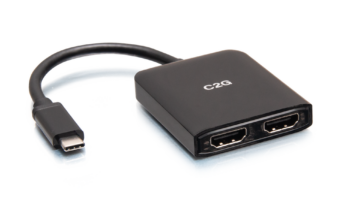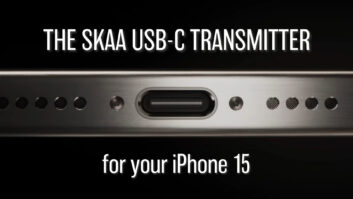
Newark, Calif. – On the heels of the Video Electronics Standards Association’s (VESA) release of the new DisplayPort 1.3 spec comes word of a liaison between VESA and the USB 3.0 Promoter Group to publish the DisplayPort Alternate Mode (“Alt Mode”) on USB Type-C Standard.
DisplayPort Alt Mode will enable a USB Type-C connector and cable to deliver full DisplayPort audio/video (A/V) performance, driving monitor resolutions of 4K and beyond, SuperSpeed USB (USB 3.1) data, and up to 100 watts of power—over a single cable, VESA said.
The DisplayPort Alt Mode can also drive adapters that support the installed base of existing DisplayPort, HDMI, DVI, and VGA displays.
The USB Type-C specification was announced in December and was finalized in August, offering a number of improvements to the Type-A USB plugs, including smaller size for portable devices and a reversible connection.
The groups said they used the Alternate Mode functional extension of the USB Type-C specification to develop the new standard for DisplayPort, which is robust connection for IT display products, such as PC monitors and even some Ultra HDTVs.
The DisplayPort Alt Mode repurposes some or all of the four existing SuperSpeed USB lanes to deliver full DisplayPort performance and uses other signaling available in the USB Type-C connector for DisplayPort’s AUX channel and Hot Plug Detection (HPD) function.
This enables computers, tablets, smartphones, displays, and docking stations to implement the new USB Type-C connector at both ends while using the DisplayPort Standard over USB Type-C to transmit high-resolution A/V along with USB data and power.
Devices supporting DisplayPort Alt Mode on a USB Type-C connector can also connect to an existing DisplayPort device using a reversible USB Type-C to DisplayPort converter cable, VESA said.
Video source devices that support DisplayPort Alt Mode on a USB Type-C connector can use an appropriate adaptor to drive an HDMI, DVI or VGA display.
All adaptors and converter cables will comply with all USB Type-C characteristics, including reversible plug orientation and cable direction.
“The USB Type-C specification was developed to provide consumers with a robust connector for everything from mobile devices to PCs, and when combined with SuperSpeed USB 10 Gbps and USB Power Delivery, it truly enables a single cable solution for the market,” said Jeff Ravencraft, USB-IF president/COO.
The USB-IF is also in the process of developing joint port identification guidelines, according to the statement. The two groups said they are working on method whereby consumers can recognize when DisplayPort Alt Mode is supported on USB Type-C devices.
Like USB, DisplayPort uses a packetized data structure and differential AC-Coupled signal “lanes” that carry high-speed data with an embedded clock. This allows the same electrical circuits and cables to carry either SuperSpeed USB data, at up to 10 Gbps per lane, or DisplayPort, at up to 8.1 Gbps per lane, as defined in the new DisplayPort 1.3 standard.
According to VESA, early implementations of DisplayPort Alt Mode USB Type-C devices will likely use existing DisplayPort 1.2a capabilities that support up to 5.4 Gbps per lane.
The just announced DisplayPort 1.3 standard (which is apparently not expected to be supported in early implementations of DisplayPort Alt Mode USB Type-C) increases overall transmission bandwidth to 32.4Gbps and brings support for HDMI 2.0 compatibility mode with HDCP 2.2 content protection, necessary for transmitting copy projected 4K video content.
Yet, VESA said using v1.2a’s 5.4 Gbps across all four high-speed lanes will support up to 4K (4096 by 2160) display resolutions at a 60Hz frame rate with up to 30-bit color.
By leveraging USB Type-C’s flexibility, the DisplayPort Alt Mode can choose to transmit on just one or two of the four available lanes so that the other two lanes can be used for SuperSpeed USB data at the same time. In a docking-station connection, for example, the use of two lanes for DisplayPort at 8.1Gbps per lane would allow simultaneous transfer of SuperSpeed USB data (up to 10Gbps in each direction) while also supporting a 4K UHD (3840 by 2160) DisplayPort monitor.
The dock can also be configured with DisplayPort protocol converters to support HDMI, VGA and/or DVI monitors. When using all four lanes for DisplayPort Alt Mode, which could drive a monitor with up to 5K (5120 by 2880) resolution, USB 2.0 data can still be carried across the USB Type-C connection using separate pins dedicated for that function.
“DisplayPort has played a vital role in advancing display performance and connectivity for platforms that are increasingly integrated and compact,” stated Craig Wiley, VESA marketing task group chairman and Parade Technologies marketing director. “In addition to the dedicated DisplayPort connector, the DisplayPort Standard has become an important ingredient in other wired interfaces, such as ThunderBolt, DockPort, MyDP, and Embedded DisplayPort.
“The opportunity to utilize the USB Type-C specification to develop the DisplayPort Alternate Mode helps further VESA’s vision of common-place high performance video interfaces,” he added.













